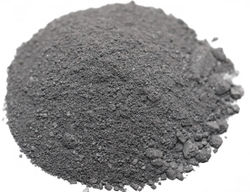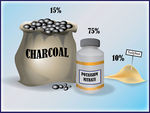Gunpowder
Gunpowder is an explosive consisting of a powdered mixture of saltpeter, sulfur, and charcoal. The earliest known propellant explosive, gunpowder has now largely been superseded by high explosives, although it is still used for quarry blasting and in fuses and fireworks.
Composition
Gunpowder is made up of three parts the first one is potassium nitrate. Potassium Nitrate is a chemical formula known as KN03 [1]. It is an ionic salt of potassium ions K+ and nitrate ions NO3-, and is therefore an alkali metal nitrate. It is a natural source of nitrate. It has been used as a constituent for multiple purposes, such as food preservatives, fertilizers, tree stump removal, rocket propellants and fireworks. Potassium nitrate is a common active ingredient in denitrifies where it exerts an antisensitivity action. It provides increasing protection against painful sensitivity of the teeth to cold, heat, acids, sweets or contact [1]. Potassium Nitrate looks to be white to dirty grey crystals as a solid. It is noncombustible by itself, but makes an impressive accelerate to combustible materials. If there is a large amount in a fire or the combustible materials is finally divided it could cause an explosion. It may explode under extreme heat or fire. It does have some therapeutic uses such sensitive tooth brand toothpastes. It does a fatal dose somewhere in-between 15 to 320G, but larger doses have been taken with no side effects [1].
The second item is Charcoal Powder, essentially crushed charcoal which is half burnt wood. People have been making charcoal since about 4000 BC in both China and West Asia. North and South American people, Africans, and Europeans also made and used charcoal. The way people made charcoal was generally by piling wood up and covering it with dampened dirt, and then lighting the wood on fire, so that it burned very slowly without much oxygen. The best charcoal comes from burning hard wood like oak. [2]. People have been making charcoal since about 4000 BC in both China and West Asia. North and South American people, Africans, and Europeans also made and used charcoal during the same time frame, the way people made charcoal was usually by piling wood up and covering it with dampened dirt, and then lighting the wood on fire, so that it burned very slowly without much oxygen. The best charcoal comes from burning hard wood like oak or birch in a fire with little to no oxygen [2]. Charcoal itself again is not really dangerous, out has many useful features such as a charcoal filter for water. It seems odd that a black powder can be used for cleaning your teeth but that is another feature of charcoal powder. It can be used to eliminate bloating and gas pains. It can be used for mold cleaning and also for alcohol poisoning. People isle it for facial cleansers such as a wearable mask to help your skin. This is another product that can be made at home with a sinister use if combined with other products such as our third ingredient.
Sulfur the bright yellow element that smells like rotten eggs [3]. The element was known in the bible as brimstone and is abundant in nature. It was used for many purposes in ancient times [3]. None metal sulfur is the 10th most abundant element in the universe, but today its most common use is for making sulfuric acid. This is used to make batteries, cleaner sand fertilizers. [3]. Pure sulfur is odorless unlike the way most people are aware of it. One interesting thing about sulfur is one of its compounds called mercaptans is what gives skunks their scent [3]. The element of biblical proportions is sulfur. It is number 16 on the periodic table and even has its own part in a Psalm. "on the wicked he will rain fiery coals and burning sulfur; a scorched wind will be their lot" Psalm 11:6 [3]. Some interesting facts about sulfur. It makes up 3 percent of the Earths mass. It is not known where the name sulfur came from, but it is thought to be from Arabic for yellow. This is the third part of a very explosive item, by themselves they are harmless, but add them in proper portions together and you have the making for a bullet, hand grenade or even a bomb.
History of Invention
During the Han Dynasty as man named Wei Boyang was the first person to mention gun powder in his writings [4]. He spoke of three powders that would "fly and dance" violently, no one is positive he was speaking off gun powder [4]. Gun powder is the only currently known explosive that uses three separate ingredients as mentioned by Boyang. It is thought he may have been a Taoist trying to find potion to live forever [4]. By 300 AD, a Jin dynasty scientist named Ge Hong had certainly written down the ingredients of gunpowder and described the explosion. People have made gunpowder by mixing sulfur, charcoal, and saltpeter, or potassium nitrate [4]. The ratios of which the three powders are mixed together are about fifteen parts of saltpeter to three parts of charcoal and two parts of sulfur. [4] The reason gunpowder explodes is that as it burns it releases gases that are bigger in volume than the original powder making an explosion or a way to move a projectile. During the rule of the T'ang Dynasty in around 700AD people began using gunpowder to create firework displays and sometime around the year 904 AD the people began to see a use for it as a weapon [4]. Chinese inventors saw a a way you could use this as a powerful weapon. The army first used the gunpowder as a way to propel rockets. They would use a small stones like cannon balls in a bamboo tube which shot the cannon balls out by lighting the gunpowder on the other end [4].
Modern Use
Gun powder has changed how much of the world looks, protects, and even works since its invention all those years ago. It is hard to believe an item that was used in a quest for immortality can remind us how mortal we really are in the the blink of an eye. This one achievement proved to be the most deadly only to the atom bomb being built [3] While gun powder was an accident it was intended for the extention of life in 850 A.D. Since it was invented it has been used for almost every weapon every creation, starting with the fiery arrow, rifles, cannons and hand grenades. Gun powder has made warfare into a very different art than it started [3]. The invention of gun powder was a costly on tin the beginning. It seems it may have cost houses and even bunt hands and faces of the inventors as they learned to control the product [3]. The Chinese forts used their invention against the Mongols during their numerous raids in the form of flying fire. Arrows that had a fixed amount of gunpowder in a tube that was attached to an arrow and fired beyond enemy lines. Over the next centuries the Chinese invented many other items were invented using gunpowder such as cannons and even grenades [3]. It is thought the psychological effect of the new technology was one of the things that helped them win the war with the Mongols. The Chinese kept the information on how to make the product to themselves until 1350 when it was passed along the silk trader route. It was shared with the Islamic world and the Europe. [3].
All of this new technology such as cannons rendered the older and not outdated method of fortifications unless. The next step into the modernization of weapons was to miniaturized the cannon. So began the pistol and the new types of armies in the world. Shrinking the cannon and adding it to the hands of soldier created portable guns for infantry men, the was the begin of the modern armies of today [3].
Video
Home made gun powder in three easy steps
References
- ↑ 1.0 1.1 1.2 National Center for Biological. Information. "PubChem". Web November 27, 2017. (accessed)
- ↑ 2.0 2.1 Carr, Karen. [1] "quatr.us". November 28, 2017. (accessed)
- ↑ 3.00 3.01 3.02 3.03 3.04 3.05 3.06 3.07 3.08 3.09 3.10 Pappas, Stephanie. [2] "Live science". web November 28, 2017 (accessed) Cite error: Invalid
<ref>tag; name "live" defined multiple times with different content - ↑ 4.0 4.1 4.2 4.3 4.4 4.5 4.6 K, Carr. [3] "Quatrs professor Carr". Web November 16, 2017 (accessed).
| ||||||||||||||


